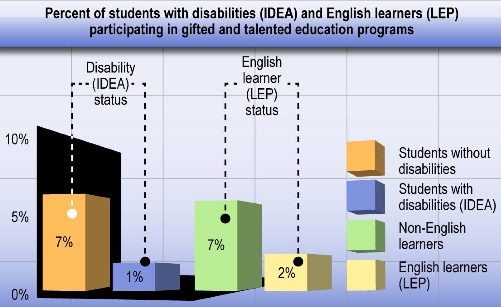In March 2014, for the first time in nearly 15 years, The U.S. Department of Education’s Office for Civil Rights (OCR) released the first comprehensive look at civil rights data from every public school in the country.
“This critical report shows that racial disparities in school discipline policies are not only well-documented among older students, but actually begin during preschool,” said Attorney General Eric Holder.
This data also reveals how students with disabilities are impacted.
For parents who wonder if their kids with disabilities face the same challenges as their non disabled peers, NCLD has summarized the statistics.
New Data Show Kids With Disabilities Shut Out of Gifted Programs, Held Back More Often Than Others
“The CDRC data show students with learning and attention issues lack access to gifted and talented programs and rigorous AP-level courses:
• Only 1 percent of students who receive IDEA services are in gifted and talented education programs, compared to 7 percent of general education students.
• Students who receive IDEA services make up 12 percent of all high school students but are only 2 percent of students enrolled in an AP course.
• Only 63 percent of students who receive IDEA services attend schools that offer math and science courses (like Algebra I, geometry, Algebra II, calculus, biology, chemistry and physics) compared to 69 percent of students without disabilities.”
There is a higher rate of retention for students with disabilities. Kids with disabilities are suspended at twice the rate of other students.
Read more from NCLD.
Key findings of the CDRC data include:
- Access to preschool. About 40% of public school districts do not offer preschool, and where it is available, it is mostly part-day only. Of the school districts that operate public preschool programs, barely half are available to all students within the district.
- Suspension of preschool children. Black students represent 18% of preschool enrollment but 42% of students suspended once, and 48% of the students suspended more than once.
- Access to advanced courses. Eighty-one percent (81%) of Asian-American high school students and 71% of white high school students attend high schools where the full range of math and science courses are offered (Algebra I, geometry, Algebra II, calculus, biology, chemistry, physics). However, less than half of American Indian and Native-Alaskan high school students have access to the full range of math and science courses in their high school. Black students (57%), Latino students (67%), students with disabilities (63%), and English language learner students (65%) also have less access to the full range of courses.
- Access to college counselors. Nationwide, one in five high schools lacks a school counselor; in Florida and Minnesota, more than two in five students lack access to a school counselor.
- Retention of English learners in high school. English learners make up 5% of high school enrollment but 11% of high school students held back each year.
Learn more about Twice-Exceptional Children on Wrightslaw at https://www.wrightslaw.com/info/2e.index.htm






My daughter 9 year old who is African American is Twice Exceptional, and public school district not wanting to provide this program for her specific needs with academic advanced classes and behavioral/emotional and ADHD services. Sent me an e-mail district only has G/T program and Special Ed not both, in Texas. Not getting anywhere yet, how can I advocate for my students needs as Twice Exceptional in public school? I have contacted many agencies, departments, out of state resources, educational advocate, and lawyer on this. US Dept of ED defers to IDEA, and IDEA’s position is “neutral”….daughter has IDEA protection of what? She is Twice Exceptional with an extreme intellectual & cognitive function and ADHD……..need advisement now, thank you
Susan, it is not clear if the district has identified her as a child with a disability under IDEA. IDEA’s position on this is not “neutral”. I work for the TX parent training, & information center. We can assist you. You can go to our website,& find the staff person who works with your area of the state. http://www.prntexas.org
In my experience, there is a lot of pushback from teachers and administrators when it comes to implementing an IEP in an AP, or even a Pre-Ap class. My son, who is predominantly ADHD, was in gifted classes from kindergarten on. He completed fifth grade in a summer and started middle school a year early. He took Pre-AP Algebra and Geometry before high school. Yet, I had several teachers at our first high school IEP meeting first express “concerns” about him being in Pre-AP at all. When I insisted, the focus moved to services and accommodations like supplying copies of class notes and giving extra time to turn in assignments (we’re talking 1 day or even 1 class period here as it’s mainly a problem of misplacing or forgetting to bring the assignment) unfairly diminishing the “rigor” of the curriculum. I still fight this on a weekly basis.